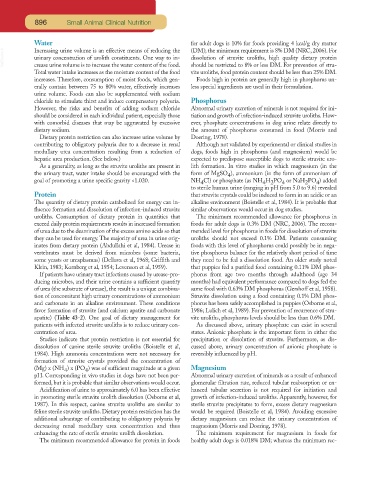Page 865 - Small Animal Clinical Nutrition 5th Edition
P. 865
896 Small Animal Clinical Nutrition
Water for adult dogs is 10% for foods providing 4 kcal/g dry matter
VetBooks.ir Increasing urine volume is an effective means of reducing the (DM); the minimum requirement is 8% DM (NRC, 2006). For
dissolution of struvite uroliths, high quality dietary protein
urinary concentration of urolith constituents. One way to in-
should be restricted to 8% or less DM. For prevention of stru-
crease urine volume is to increase the water content of the food.
Total water intake increases as the moisture content of the food vite uroliths, food protein content should be less than 25% DM.
increases. Therefore, consumption of moist foods, which gen- Foods high in protein are generally high in phosphorus un-
erally contain between 75 to 80% water, effectively increases less special ingredients are used in their formulation.
urine volume. Foods can also be supplemented with sodium
chloride to stimulate thirst and induce compensatory polyuria. Phosphorus
However, the risks and benefits of adding sodium chloride Abnormal urinary excretion of minerals is not required for ini-
should be considered in each individual patient, especially those tiation and growth of infection-induced struvite uroliths. How-
with comorbid diseases that may be aggravated by excessive ever, phosphate concentrations in dog urine relate directly to
dietary sodium. the amount of phosphorus consumed in food (Morris and
Dietary protein restriction can also increase urine volume by Doering, 1978).
contributing to obligatory polyuria due to a decrease in renal Although not validated by experimental or clinical studies in
medullary urea concentration resulting from a reduction of dogs, foods high in phosphorus (and magnesium) would be
hepatic urea production. (See below.) expected to predispose susceptible dogs to sterile struvite uro-
As a generality, as long as the struvite uroliths are present in lith formation. In vitro studies in which magnesium (in the
the urinary tract, water intake should be encouraged with the form of MgSO ), ammonium (in the form of ammonium of
4
goal of promoting a urine specific gravity <1.020. NH Cl) or phosphate (as NH H PO or NaH PO ) added
4
2
4
4 2
4
to sterile human urine (ranging in pH from 5.0 to 9.6) revealed
Protein that struvite crystals could be induced to form in an acidic or an
The quantity of dietary protein catabolized for energy can in- alkaline environment (Boistelle et al, 1984). It is probable that
fluence formation and dissolution of infection-induced struvite similar observations would occur in dog studies.
uroliths. Consumption of dietary protein in quantities that The minimum recommended allowance for phosphorus in
exceed daily protein requirements results in increased formation foods for adult dogs is 0.3% DM (NRC, 2006). The recom-
of urea due to the deamination of the excess amino acids so that mended level for phosphorus in foods for dissolution of struvite
they can be used for energy.The majority of urea in urine orig- uroliths should not exceed 0.1% DM. Patients consuming
inates from dietary protein (Abdullahi et al, 1984). Urease in foods with this level of phosphorus could possibly be in nega-
vertebrates must be derived from microbes (some bacteria, tive phosphorus balance for the relatively short period of time
some yeasts or ureaplasmas) (Delluva et al, 1968; Griffith and they need to be fed a dissolution food. An older study noted
Klein, 1983; Kornberg et al, 1954; Levenson et al, 1959). that puppies fed a purified food containing 0.11% DM phos-
If patients have urinary tract infections caused by urease-pro- phorus from age two months through adulthood (age 34
ducing microbes, and their urine contains a sufficient quantity months) had equivalent performance compared to dogs fed the
of urea (the substrate of urease), the result is a unique combina- same food with 0.63% DM phosphorus (Gershoff et al, 1958).
tion of concomitant high urinary concentrations of ammonium Struvite dissolution using a food containing 0.1% DM phos-
and carbonate in an alkaline environment. These conditions phorus has been safely accomplished in puppies (Osborne et al,
favor formation of struvite (and calcium apatite and carbonate 1986; Lulich et al, 1989). For prevention of recurrence of stru-
apatite) (Table 43-2). One goal of dietary management for vite uroliths, phosphorus levels should be less than 0.6% DM.
patients with infected struvite uroliths is to reduce urinary con- As discussed above, urinary phosphate can exist in several
centration of urea. states. Anionic phosphate is the important form in either the
Studies indicate that protein restriction is not essential for precipitation or dissolution of struvite. Furthermore, as dis-
dissolution of canine sterile struvite uroliths (Boistelle et al, cussed above, urinary concentration of anionic phosphate is
1984). High ammonia concentrations were not necessary for reversibly influenced by pH.
formation of struvite crystals provided the concentration of
(Mg) x (NH ) x (PO ) was of sufficient magnitude at a given Magnesium
4
4
pH. Corresponding in vivo studies in dogs have not been per- Abnormal urinary excretion of minerals as a result of enhanced
formed, but it is probable that similar observations would occur. glomerular filtration rate, reduced tubular reabsorption or en-
Acidification of urine to approximately 6.0 has been effective hanced tubular secretion is not required for initiation and
in promoting sterile struvite urolith dissolution (Osborne et al, growth of infection-induced uroliths. Apparently, however, for
1987). In this respect, canine struvite uroliths are similar to sterile struvite precipitates to form, excess dietary magnesium
feline sterile struvite uroliths. Dietary protein restriction has the would be required (Boistelle et al, 1984). Avoiding excessive
additional advantage of contributing to obligatory polyuria by dietary magnesium can reduce the urinary concentration of
decreasing renal medullary urea concentration and thus magnesium (Morris and Doering, 1978).
enhancing the rate of sterile struvite urolith dissolution. The minimum requirement for magnesium in foods for
The minimum recommended allowance for protein in foods healthy adult dogs is 0.018% DM; whereas the minimum rec-

